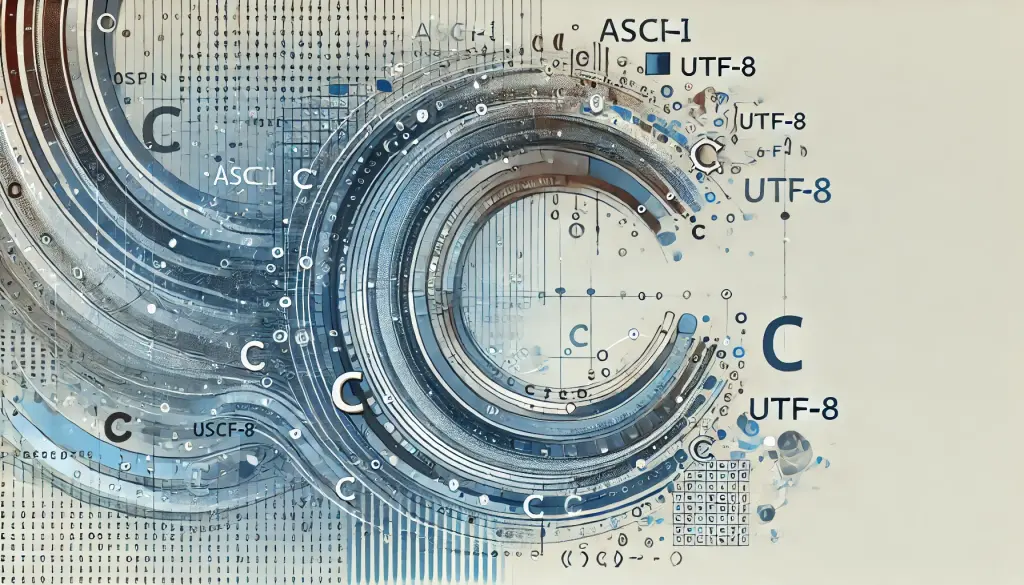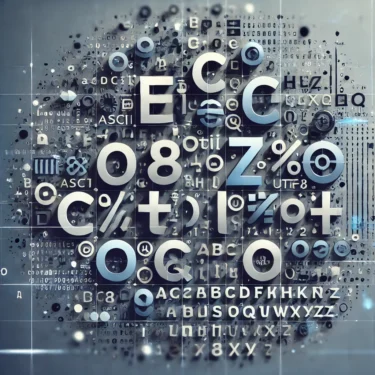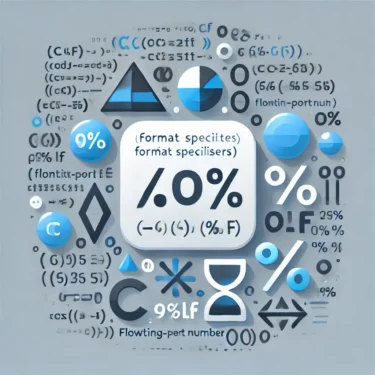- 1 1. Introduction
- 2 2. What Is Character Encoding in C? Basics and Types
- 3 3. Basic Handling of Characters and Character Encoding in C
- 4 4. Retrieving and Displaying Character Codes in C
- 5 5. Character Encoding and String Manipulation in C
- 6 6. Handling Japanese Characters and Important Considerations
- 7 7. Converting Character Encodings and Compatibility in C
- 8 8. Conclusion
1. Introduction
In the C programming language, a “character encoding” is the fundamental system for representing characters as numeric values, enabling programs to handle them effectively. Understanding character encoding is crucial, especially when supporting multiple languages like Japanese, to prevent garbled text and data processing errors. In this article, we will explain everything from the basics of character encoding in C, to handling different encodings, and important considerations for string manipulation. By the end, you will have a solid grasp of character handling and encoding in C, along with practical skills you can apply.
2. What Is Character Encoding in C? Basics and Types
The Basics of Character Encoding
Character encoding is a standard for representing characters as numeric values so that computers can interpret them. For example, in ASCII, the letter “A” corresponds to the numeric value 65. Many programming languages, including C, handle and display characters through such encodings.
Common Types of Character Encoding
ASCII
ASCII (American Standard Code for Information Interchange) is a 7-bit character set that includes letters, digits, and symbols, and it serves as the basic character encoding in C. ASCII codes range from 0 to 127 and are designed for English-language character representation.
Unicode and UTF-8
Unicode is a character encoding standard developed for multilingual support. UTF-8 is one of its encoding schemes, using variable-length encoding and maintaining compatibility with ASCII. UTF-8 is widely used in systems and web environments where multilingual support is essential.
Shift_JIS and EUC-JP
In Japanese environments, character encodings such as Shift_JIS and EUC-JP are used. Shift_JIS is commonly used in Windows environments, representing Japanese kanji and katakana in 2 bytes. EUC-JP is primarily used in UNIX-based systems and supports Japanese characters using a structure different from Shift_JIS.
3. Basic Handling of Characters and Character Encoding in C
Basics of the char Type
In C, characters are represented using the char type. A char occupies 1 byte of memory and stores the numeric value corresponding to the character’s encoding. Below is a basic example of using the char type:
char letter = 'A'; // Assign a character directly
char code = 65; // Assign an ASCII code as a numberUsing Escape Sequences
Special notations called escape sequences are used to represent certain operations. For example, \n represents a newline, and \t represents a tab.
char newline = '\n'; // Newline character
char tab = '\t'; // Tab characterUsing escape sequences allows you to handle control characters effectively in a program.
4. Retrieving and Displaying Character Codes in C
This section explains how to retrieve character codes in C and display them.
Displaying Character Codes with printf
In C, you can easily display a character and its code using the printf function.
#include <stdio.h>
int main() {
char ch = 'A';
printf("Character: %c, ASCII Code: %d\n", ch, ch); // Display character and code
return 0;
}This code outputs the character 'A' and its ASCII code, 65.
Displaying a Range of Character Codes
You can display all characters and their codes within a specified range. For example, the following code prints ASCII characters in the range 32–126:
#include <stdio.h>
int main() {
for (int code = 32; code <= 126; code++) {
printf("ASCII code %d: %c\n", code, (char)code);
}
return 0;
}
5. Character Encoding and String Manipulation in C
When working with strings, understanding character encoding and using the right functions is crucial.
Safe String Copying with strncpy
The strncpy function allows you to copy strings safely by specifying the destination buffer size, helping prevent buffer overflows. Using strcpy without enough buffer space can cause memory issues, so strncpy is recommended.
#include <stdio.h>
#include <string.h>
int main() {
char src[] = "Hello";
char dest[10];
strncpy(dest, src, sizeof(dest) - 1); // Safe copy
dest[sizeof(dest) - 1] = '\0'; // Add null terminator explicitly
printf("Copied string: %s\n", dest);
return 0;
}Comparing Strings with strcmp
To compare strings, use the strcmp function to determine whether two strings are equal.
#include <stdio.h>
#include <string.h>
int main() {
char str1[] = "Apple";
char str2[] = "Banana";
int result = strcmp(str1, str2);
if (result == 0) {
printf("The strings are equal.\n");
} else {
printf("The strings are not equal.\n");
}
return 0;
}6. Handling Japanese Characters and Important Considerations
To handle multibyte characters like Japanese correctly in C, you must specify the proper character encoding. If Japanese text appears garbled, the encoding may not match.
Sample Code: Displaying Japanese with setlocale
The following example shows how to display Japanese text in UTF-8 in C:
#include <stdio.h>
#include <locale.h>
int main() {
setlocale(LC_ALL, "ja_JP.UTF-8"); // Set to UTF-8 Japanese
printf("こんにちは\n"); // Output Japanese text
return 0;
}7. Converting Character Encodings and Compatibility in C
To convert between different encodings, the iconv library is commonly used. The following example converts from Shift_JIS to UTF-8:
#include <stdio.h>
#include <stdlib.h>
#include <iconv.h>
int main() {
iconv_t cd = iconv_open("UTF-8", "SHIFT_JIS"); // Initialize converter
char sjis_str[] = "こんにちは";
char utf8_str[100];
char *inbuf = sjis_str;
char *outbuf = utf8_str;
size_t inbytesleft = strlen(sjis_str);
size_t outbytesleft = sizeof(utf8_str) - 1;
iconv(cd, &inbuf, &inbytesleft, &outbuf, &outbytesleft);
printf("UTF-8: %s\n", utf8_str);
iconv_close(cd);
return 0;
}8. Conclusion
Understanding how to handle character encoding in C is essential when developing multilingual applications, especially those that include Japanese. By using safe functions like strncpy and encoding conversion tools like iconv, you can prevent garbled text and data handling errors.




